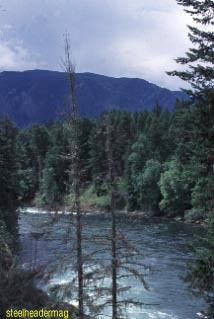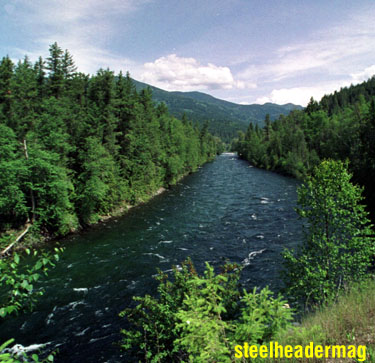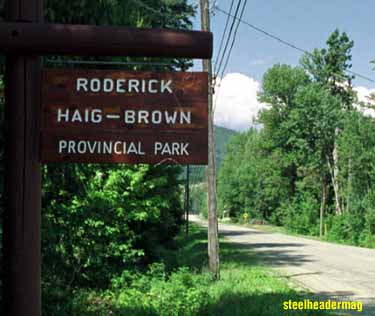|

Adam’s Legends
The Steelheader
Perched on a fine stretch of Little Shuswap Lake shoreline is a lodge
called Quaaout. We stayed here for four days in late June. Shuswap Band
members conceived the idea of a hotel in 1979 to spirit economic development.
Elder and former chief William Arnouse named the lodge “Quaaout" which
means “Where the sun’s rays first hit the water" in Secwepemec. Councillor
John and chief Arnouse worked closely with the architects in designing the
Kekuli (Shuswap Winter Home) that is now the hotels magnificent Lobby. The
Quaaout Lodge held its grand opening ceremonies on June 29, 1992.
The Shuswap nation has relied on Shuswap sockeye for food and cultural
purposes for centuries.
When the Adams River Sockeye make their journey to the Fraser and squeeze
through the bottleneck confines of Hell’s Gate they are about 35 kilometers
from the Mouth of the Thompson River at Lytton and well on their way to their
natal river the Adams.
Traveling at 29 kilometers per day it takes 18 days for a Sockeye to get
to the Adams river from the mouth of the Fraser river.
Things get tough on the Fraser around Yale. A small town on the Fraser
that at one time had a population of 50,000 people.
Hell’s Gate, however, is the narrowest part of the Fraser river at 110 feet
wide and at high water more than 200 million gallons of water per minute flow
through this intense gorge. In 1914 a rockslide blocked the passage at Hell’s
Gate filtering Sockeye runs to 36% of their former size by 1921. The pink
salmon run was almost enilated at this time.
To help stocks rebuild The Pacific Salmon Commission built the fishways at
Hell’s Gate in 1944. These impediments slow the river to 5km/hr making it
easier for all species of salmon and steelhead to pass Hell’s Gate on journey
to their redds.
Once sockeye have reached the Adams River, which flows into Shuswap Lake,
they spawn. After Sockeye alevin emerge they spend a year in fresh water
before heading for the ocean. The entire sockeye population of the area
revolves on a 4 year cycle. The first year of the cycle is the smallest in
size while the last or fourth year has the largest numbers of sockeye.
 Roderick Haig-Brown Provincial Park nestles on the mouth of the Adams and
tourists from all over the world come to this location during the fall months
to witness the sockeye’s return to spawn. Here during peak season in mid
October the sandy beaches along Shuswap Lake and Haig-Brown park are strewn
with sockeye carcasses dead, spawning and clinging to the last breath of life.
Roderick Haig-Brown Provincial Park nestles on the mouth of the Adams and
tourists from all over the world come to this location during the fall months
to witness the sockeye’s return to spawn. Here during peak season in mid
October the sandy beaches along Shuswap Lake and Haig-Brown park are strewn
with sockeye carcasses dead, spawning and clinging to the last breath of life.
During his active days Haig-Brown traveled to The Adams to witness the
sockeye runs and I’d imagine to hook a few of the large Shuswap rainbows.
Large ‘bows now as in previous days follow the sockeye up the Fraser and
Thompson rivers. The provincial government couldn’t have picked a better name
to describe this legend. Both the river and the man are legends. Haig-Brown, a
magistrate in Campbell river, is still considered the Dean of Sportfishing
writers to this day even though he has been dead for some 27 years. Haig-Brown
has 27 books to his credit and for someone who was essentially self taught he
still ranks as one of our greatest Canadian literary ambassadors to
sportfishing and outdoor writing. He fished solely with a fly and used a
floating line.
It’s with this true honor that Shuswap’s Quaaout Lodge cohabitates with
the legend of the Adams River sockeye forever enshrined with the presence of
Roderick Haig-Brown’s name and reputation.
If you have read any of Haig-Brown’s books you’d witness true greatness as
his sentences range from simple meandering thoughts to the challenging but
always charming chapters shelled in a book of fly-fishing adventures both on
the Campbell river and other rivers and lakes like the Adams.
We were lucky enough to flyfish the very waters of the Adams river that Haig-Brown
fished.
In the Shuswap Lake and Adams Lake region sport fishing is world renowned.
In one edition of the Field and Stream magazine a writer referred to the
rainbow in this region as “salmon eating trout." In a sense this is correct in
that the rainbow that frequent the Adams system do eat sockeye fry. The
hottest streamer fly here is indeed a sockeye fry imitation and trout up to
18lbs can be tricked into snapping at these offerings. The largest rainbow
this writer has caught in the Adams area is 12 pounds and that is about 9
pounds more trout than I’d been used to catching.
Finding rainbows here is not difficult unless you run into an off day.
Because of bait bans in the region the most common sport fishing technique is
fly fishing. We used a medium sinking line in the mouth of the Adams with a
sockeye streamer imitation. When an aggressive rainbow over ten pounds hit the
fly it’s a marvel to watch. You’d see a large rainbow doing cartwheels and
back flips as he ravages your gear. I’ve seen a couple hundred yards of fly
backing disappear into the deep green cool waters of Shuswap lake from the
mouth of the Adams many times. The rainbows spare no mercy. They tear into
your gear like tanks.
On the day I went out I couldn’t find a fish if my life depended on it.
We were at the tail end of freshet in Mid June and as with other systems
the fish were lost in all the water. The only advantage we had was the fact
that during the mid April to June time period Shuswap Lake trout were
finishing up there spawning cycle. And indeed the young man that helped us at
Chase True Value Hardware store told us that he’d pumped the stomachs of some
‘bows that he’d caught and found eggs. I assumed that these would be trout
eggs.
Nevertheless after spending the entire morning on my first day trying to
find likely trout hideaways I settled on the outlet of Adams Lake. Here there
is a 300 yard pool that holds trout before the Adams turns into a frothy white
turbulance and smacks through the canyons on a 10 km + run into Shuswap lake.
It was a classic encounter in that I was using the standard sockeye
imitation streamer catching nothing while trout jumped all around my
presentation. I switched to a half back - still nothing. I tried several trout
patterns and still couldn’t create any interest.
Then I remembered Phil Rowley’s trout seminar from Hub Sports in Abby.
Rowley suggested that you look around the area and carefully observe Mother
Nature’s Plan. Chances are the trout will be tuned into this scheme of things.
Rowley was right –– I observed hundreds of dragon flies doing the wild thing
 and every once and a while you could see them fall into the river and wham,
they disappeared in a silver-mirrored flash as a trout nailed them from the
surface. You could see the long slender females planted on leaves of the
surrounding shrubbery often with a male glued on its back. and every once and a while you could see them fall into the river and wham,
they disappeared in a silver-mirrored flash as a trout nailed them from the
surface. You could see the long slender females planted on leaves of the
surrounding shrubbery often with a male glued on its back.
I
had a fly imitation of this very act –– two dragon flies in ecstasy and boy I
tell you the trout must have developed a peeping trout instinct ‘cause just
about every cast produced a rainbow from one to 6lbs. !!!
I tossed the imitation into the slow moving current and mended the
floating line to get a dead drift (natural imitation) and Bang- fish on.
These fiesty rainbows came out of nowhere and hovered under the fly like
aggressive line backers. Some ‘bows shot up from the bottom of the pool and
hit the presentation cartwheeling, spiraling and spinning in mid air up to 15
feet above the rivers surface.
I left my rod unattended with the fly still in the water –– of course a
fish hit the fly and the rod started for the river - I hopped and jumped about
twenty yards and just caught the rig before it went into the river- no bull -
the reel was just going over the railing of a bridge –– sage rod, floating
line and all.
After an afternoon of this amazing show of catch and release I went back
to the Quaaout lodge tired, sun beaten and hungry. I felt as if I had just
revisited a bunch of old friends. Previously I had spent at least 7
spring/summers on the lake while writing columns for local newspaper.
Because of the popularity of the Shuswap system and its close proximity to
Vancouver things have changed a little in the area.
The Hopps from Little Shuswap say the lake isn’t the same as it used to
be. It’s a lake playland. Anglers can no longer keep fish at Little River or
at the Adams - it’s all catch and release says the family.
 Until just recently the Shuswap Band hadn’t renewed land leases and some
lakeside cabins went real cheap. One prime cabin went for $30,00.00 and is
worth at least three times that now as the Band recently renewed leases on
Little Shuswap for another 49 years. A similar scenario happened on the Adams
Lake. Although angling opportunities have diminished on the Shuswap lake
system there is still good angling in the area. Until just recently the Shuswap Band hadn’t renewed land leases and some
lakeside cabins went real cheap. One prime cabin went for $30,00.00 and is
worth at least three times that now as the Band recently renewed leases on
Little Shuswap for another 49 years. A similar scenario happened on the Adams
Lake. Although angling opportunities have diminished on the Shuswap lake
system there is still good angling in the area.
The alternative for anglers wanting to retain fish outside of Shuswap
no-retention boundaries is to fish Adams Lake.
Adams Lake is 10 minutes north of Shuswap. Access to this 43 mile long Lake is
by ferry if you don’t have a boat. The Ferry service runs 24 hours and is on
demand; in other words they’ll come and get you when you park at the dock with
your headlights on.
You can catch Rainbows up to 20 lbs in Adams Lake. The lake is 43 miles
long and as much as 1500 feet deep in places and feeds the Shuswap system.
Adams lake itself is fed by The North Adams river which can be accessed either
by boat or the road that skirts the northern shore of the lake itself. Tum Tum
Lake feeds the north Adams river.
I spent the afternoon with guide Rick Sanford who works out of the Adams
Lake Indian Point Resort. I’d recommend Rick if you are going to this area. He
can be reached at the resort Telephone- 250 679 3441. Sanford lives on Adams
lake and has his finger on the pulse of what’s going on with the fish. A six
hour charter for 2 people costs only $200.00. When we went out with him we
enjoyed the luxury of a 28' Marlin cruiser imported from Mexico.
Aside from the popular Adams river and lake you’ll find a little less
known but productive creek that spills into the Shuswap lake called Scotch
creek.
Scotch Creek is world famous for having the richest ever “11 kilometers of
gold nuggets’’ but nobody knows the location of the mother load.
Scotch creek has a good run of sockeye as well which comes in about two
weeks ahead of the Adams River run. The Adams River run trickles into Scotch
creek in mid September whereas the Adams run starts late September and runs
into the third week of October.
Ken Salter who lived in Scotch Creek for several years caught Gerrard
rainbows in the mouth of Scotch creek. He caught about twenty-five of these
big hatchery rainbows ranging up to an unbelievable 25lbs. A lucky sports
angler caught the largest spring salmon at 2 mile creek in Anesty Arm (Shuswap
Lake). It was 39lbs. Incidentally, an angler caught the world record Kokanee
in North Barrier Lake just over the hill from Shuswap and Adams Lakes weighing
22lbs.
Tony Eberts oldest family friend was from Scotch Creek. North of Scotch creek
it’s as wild as heck and at the foot of 7,300-foot Pukeashun mountain hides
Grizzly Lake.
The Momich river which is about 8 or 10 miles from top and east side of
Adams flows into the big lake.
After removing a dam at the foot of Adams Lake the sockeye now return to the
Momich lake system and upper Adams, and on to Tum Tum Lake.
When Tony Eberts was 16 years old he and two pals went on a trek to the
Scotch creek area up the mountain to the head of Momich river to Adams lake.
They built a raft and made their way down the lake but ran out of food by
Momich lake. Tony saw a couple of salmon close to shore - he was packing a 22
calibre revolver but that old saying ‘‘it’s like shootin’ fish in a barrel’’
didn’t quite pan out –– he missed supper.
If you are planning a trip check in at Quaaout Lodge Resort “Hear the
Legend feel the Spirit.” Coming from the Coast, you drive through Chase and
then turn left, over the Little River bridge, and look for the road on the
left that takes you to the lodge.
It's a place so rich in tradition and hospitality, it is unlike any other
resort on earth. Quaaout offers unique sights, aromatic delights, a
fascinating culture and a people as warm as the sun.
A good consideration for company conventions, seminars, getaways, fishing
and golfing.
For reservations call toll free in Canada and continental USA 1-800-663-4303.
Telephone 250 679 3090 fax 250 679 3039
quaaout@quaaout.com
PO Box 1215 Chase BC Canada V0E 1M0
www.quaaout.com

Writing and Photos by Terry Hanson, Edited by Tony Eberts.
[last pic -- sockeye --
angler releasing an incidental sport caught sockeye]
-
-
|